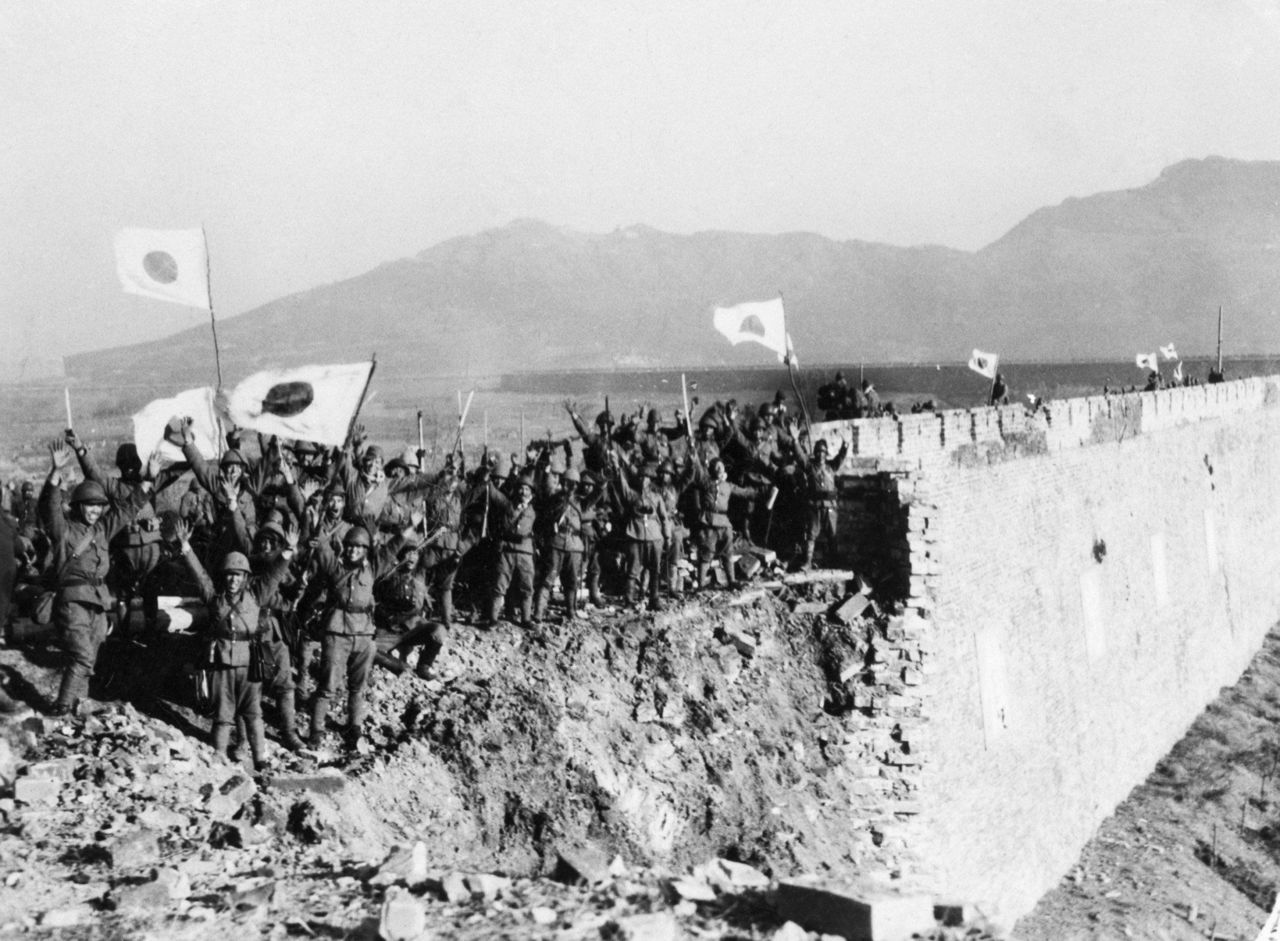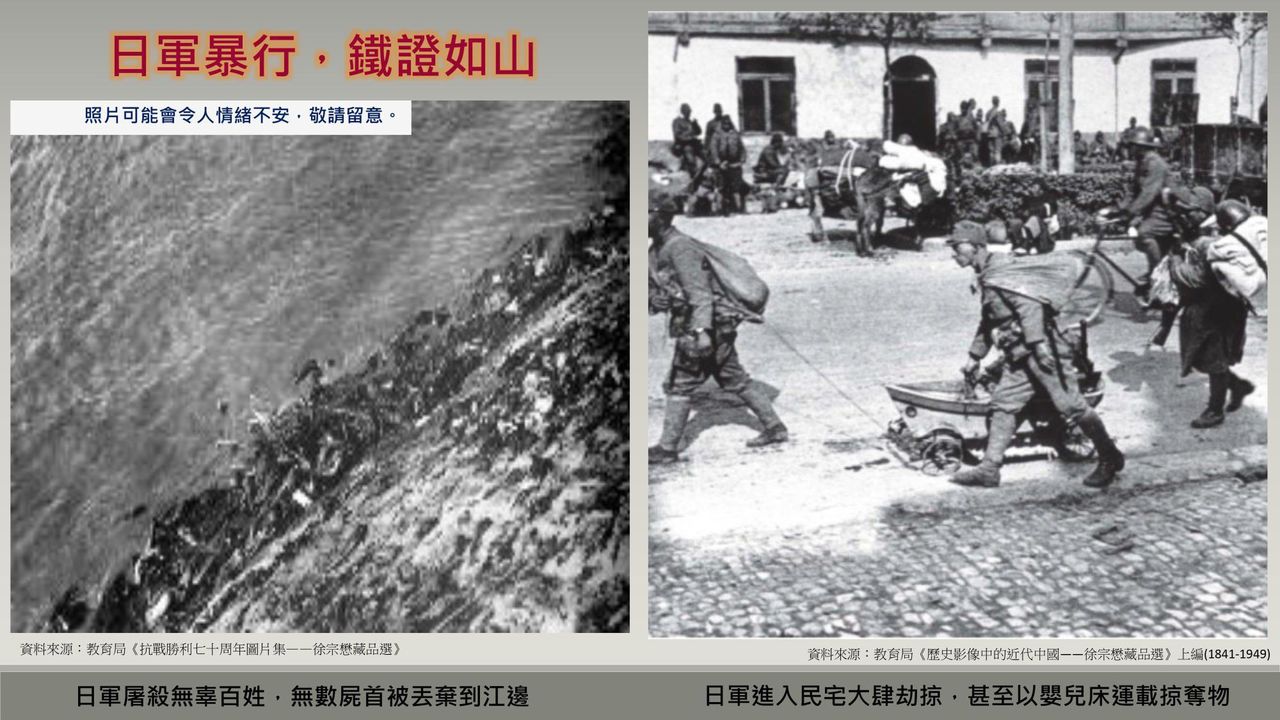Hong Kong News

Nanking massacre footage not for all Hong Kong pupils, Education Bureau says
Education authorities have stressed that teachers must use their professional judgment when deciding whether to use government-supplied learning materials after primary school pupils in Hong Kong reported feeling distraught over graphic footage of the Nanking massacre shown in the classroom.
The children, some as young as seven according to sources, watched video endorsed by the Education Bureau that included scenes of rampaging Japanese soldiers burying Chinese civilians alive and shooting them in the head, as well as fields littered with the dead, including the bodies of babies.
PLK HKTA Yuen Yuen Primary School in Tuen Mun showed the footage to the pupils, some of whom the insiders said were in Primary Two, last Thursday as part of its activities commemorating the massacre by the invading Imperial Japanese Army, which began on December 13, 1937, in the city now known as Nanjing.
China estimates that more than 300,000 people died before the slaughter ended about six weeks later.
 Japanese troops in shell-torn Nanking in 1938.
Japanese troops in shell-torn Nanking in 1938.
The school sent a statement to parents on Saturday saying it was “distressed and worried” to learn that some children felt uneasy after the class.
“Our school will pay more attention to the children’s feelings in the future, and make appropriate adjustments to the teaching materials according to different grades,” it said. “We know that national education is vital; however, we should put children’s feelings into our consideration.”
In a reply sent to the Post by the school and Po Leung Kuk, a charity that runs the institution, a spokesman said they were very concerned some pupils were disturbed by the teaching materials provided by the bureau.
“The school will pay more attention in the future, so students’ emotions and feelings will be better taken care of while they learn about the historical events,” he said.
It vowed to offer counselling to pupils and urged parents to alert teachers if their children expressed worrying feelings over the incident.
The commemoration was part of the school’s drive to follow the bureau’s call for educators to develop in students “a sense of national identity and a sense of commitment towards the nation”.
 An example of the learning materials sent to schools, containing the warning in the white box.
An example of the learning materials sent to schools, containing the warning in the white box.
One video was produced by public broadcaster RTHK and the other by the state-run Xinhua News Agency.
In addressing the controversy, the bureau on Sunday pointed out that the video in question had already been broadcast on local television and uploaded to the internet, making it information anyone could consume, the bureau said.
“School staff can choose the documentary or other materials to teach the Nanking massacre, and when using videos or images of the war, teachers should use their professional judgment and guide students adequately,” it said.
The materials, which contained links to the footage, included warnings about graphical content.
The authorities further added that teaching students about the history of the Sino-Japanese war was a “meaningful exercise” and “history is history, it cannot be avoided”.
The bureau said it hoped society could understand that teaching national history was an important part of educating the next generation, and residents should trust in teachers’ professionalism and guidance and avoid being misled by “one-sided opinions”.
PLK HKTA Yuen Yuen Primary School would still observe a one-minute moment of silence to commemorate the Nanking victims on Monday and hold a special class to “ease the children’s emotions and teach them different ways to face difficulties”.
Other schools have issued circulars to parents seeking to reassure them over lessons about the event. WF Joseph Lee Primary School in Tin Shui Wai informed parents on Saturday it would not show the footage provided by the government, which it said was more suitable to secondary school students.
Ng Wing-hung, principal of Buddhist Lim Kim Tian Memorial Primary School in Kwai Chung, said management reached the same conclusion after reviewing the two videos.
“A thorough debriefing must be conducted with the students if these clips are shown, but we just do not have enough time,” he said.
“We have to be extremely sensitive when handling the issue as children may have different reactions to it. Some may not show immediate distress in class but only later at night when they sleep. It will be very undesirable if we cannot address their emotions in a timely manner.”
Ng said his school would only brief its pupils about the incident during the morning assembly on Monday and observe the moment of silence.
Polly Chan Shuk-yee, principal at Yaumati Catholic Primary School (Hoi Wang Road), said her school would adopt a similar approach.
“We found the footage too bloody and violent and that it may scare our children,” she said, adding teachers would show only pictures depicting general scenes, such as destroyed houses.
Schools had a responsibility to screen teaching materials provided by the bureau, which were not compulsory, based on their circumstances and the maturity of the pupils, she added.
In a circular issued to all primary and secondary schools in mid-November, the bureau said it had designed a commemorative activity plan, which included playing the national anthem and showing the two clips followed by a student sharing session.
It encouraged schools to organise related activities during weekly assemblies or add them to lessons on moral and civic education, previously known as liberal studies. Teachers could take their “own contexts and needs” into consideration when using the resource kit.












The following Chiang kai shek listed atrocities are only a small sample of crimes committed, as he killed over 10 million Chinese from 1927-1949.
When the communists won their Civil War, they decided to sanitize his past by changing the narrative (sounds all too familiar) and removing him from their history books. Someone had to take the blame for his murderous spree.
Nanjing Incident, Chinese soldiers attack foreign consulates, kill Europeans, civilians and loot many buildings. 24/3/27
Hankou Incident, one hundred and fifty homes damaged, and dozens killed when the Chinese army invades and loots Japanese concessions. 3/4/27
Shanghai Massacre, (April 12 Purge) Chinese nationalists kill around 300,000 communists. 12/4/27 Japan is blamed.
The "Manchurian Incident" (Mukden Incident) Chinese bandits blow up a section of the track belonging to the Japanese owned South Manchurian Railway. Very little to no damage is done. The Chinese blame the Japanese 18/9/31
Jiangxi-Fujian Communist Purge, National Revolution Army kill 700,000 Hakka. 1931-1934
Chinese contaminate hundreds of water wells dysentery, anthrax and cholera resulting in the death of 6,000 Imperial Japanese soldiers and 2,000 horses. Civilian deaths unknown. Unit 731 builds a water purifying plant so that this never happens again. 1935
Tungchow Massacre, Chinese soldiers attack and kill more than 250 Japanese, Chinese and Korean civilians. 29/7/37
Cathay & Palace Hotels Massacre, Chinese Air Force bombed the hotels resulting in 3,500 civilians killed and wounded. China tries to blame Japan but there are too many witnesses. 14/8/37
Nanking Massacre, General Tang Shen-chih threatens to severely punish soldiers who stop fighting. He kills many of his own troops. Destroys roads, railways, bridges, sinks boats to stop escapes across the river, burned houses so that his troops have nowhere to hide.
11/12/1937. Japanese soldiers are shocked when they enter the city.
Chinese army deserters found hiding with numerous weapons inside the Nanking Safety Zone. They admit to looting and rape blaming it on the Japanese army. When arrested the atrocities stop. Minnie Vautrin was devastated that it happened on her watch. 3/1/38
Chiang kai shek breaches dykes holding back the Yellow River flooding an area of 21,000 sq. miles washing away the topsoil. This one act alone killed over a million Chinese through drownings, starvation and disease. Survivors cannot be rescued as roads, railways and bridges have been destroyed during Chiang's "scorched earth period". Chiang tries once again to blame the Japanese.
Great Changsha Fire Massacre, Chiang kai shek sends arson teams to burn the city to the ground, the greatest fire in Chinese history, more than 30,000 killed and 56,000 buildings destroyed. 13/11/38
The Taiwan "228 Massacre" in which as many as 28,000 people were raped and murdered by troops sent by the Chinese nationalist leader Chiang kai shek, many more went missing. 28/2/1947